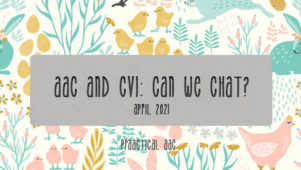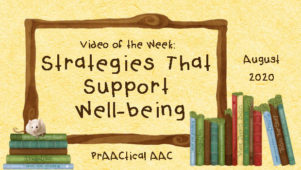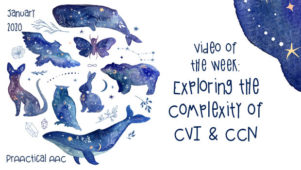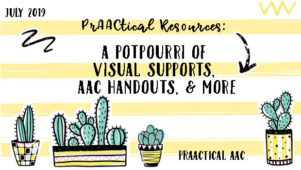AACtual Therapy-AAC in Motion: Walk the Walk, Talk the Talk with Tanna Neufeld
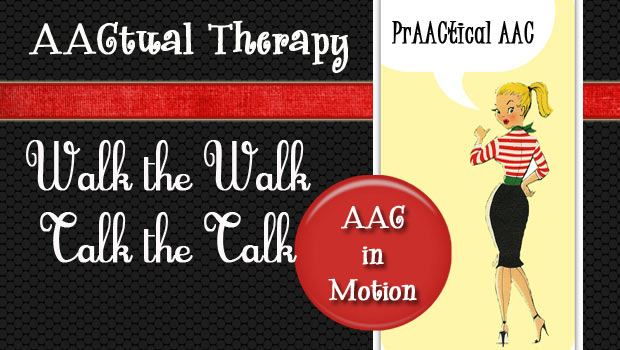
Tanna Neufeld hits another homerun with this post about co-treating children with multiple disabilities. Collaborating with our colleagues is both fun and challenging. Let’s take a look at the prAACtical ways that Tanna and her colleagues support kids with motor and visual impairments who are learning to use AAC. 
Fridays are my favorite. And not just for the obvious reasons (TGIF), but also because Fridays are one of the most challenging and exciting days of my work week. Every Friday, I am lucky enough to team with my favorite PTs for joint treatment sessions to support several children with multiple motor and communication challenges. Around our center, we lovingly refer to these kids as our “motor kids”. All of these little ones are nonverbal, and all have very complex motor challenges that significantly limit their ability to interact with traditional play and learning environments. Many of these kids also have suspected or known visual impairment and/or cortical visual impairment (CVI), further limiting their access to learning and communication opportunities. Added to this stew of complexity, all of these families are culturally and linguistically diverse, and much of our communication (with the child and his/her family) is conducted through an interpreter. Phew! Talk about a challenge! And I LOVE it!
At the start of this unique collaborative relationship with my PT colleagues (and families, AND interpreters), it was tough to find balance, and to figure out where to start. From the co-treatment perspective- how did communication fit into the blood, sweat and, tears of working on trunk control, balance, standing, and walking? How was I going to teach vocabulary-especially visual vocabulary-when the kid was moving around all over the place? And let’s not forget that these moms and dads are really focused on getting these little ones on those feet and moving-does this mean that communication must take the back seat in the co-treatment environment to let motor skills shine? Through much trial and error, and some awesome collaboration with my kids, moms and dads, and PT partners, I have learned a few things that help me navigate these AAC situations which seem at times to have more questions than answers.
In working with little ones with multiple challenges I have realized how important it is for children to experience early life through movement and sensory experiences. As Shareka so insightfully stated in her post, Fun and Functional Vocabulary, these little guys really love “people play” and moving their bodies. What better place to “talk the talk” while you “walk the walk” than in a PT session? For many of these kids, “the walk” involves swinging, bouncing on the therapy ball, tackling the gait trainer, or sweating it out with “sit to stand” activities. These unique motor activities really take that whole traditional idea of presenting a communication board full of toy choices and throw it out the window! So while my PT partners help these little guys walk the walk, I get to work weaving the AAC fabric to support communication during movement. I am always surprised to see how motivated and engaged these kids are to request, ask questions, direct action, and even comment during these movement activities. Although integrating pictures into these free flowing activities can be a bit of a juggling act, I really notice significant changes in the receptive and expressive language of these kids when I integrate some basicAAC strategies . Having the awesome knowledge of a motor therapist on board during these sessions has also helped me greatly in understanding what’s involved with bodies in motion and how to build verbal and non-verbal communication upon a solid motor foundation. Here are a few things that I regularly employ to help make these wonderful multidisciplinary sessions magical.
1. Recognize the Importance of Body Language
My motor kids come up with some pretty amazing ways to get their messages across. Even though many of them don’t have picture communication supports successfully working for them when they meet me, they all have their own unique “communication systems”. Some of my favorite moments in working with these complex kids arise in getting to know each one of these unique systems, and helping families learn how to listen and respond to their child’s nonverbal, non-symbolic communication. Recognizing, interpreting, and responding appropriately, consistently, and quickly to these less obvious, non-traditional communication acts helps these kids know that we are looking and listening. When we are quiet long enough to let them “talk”, they initiate communication before we even present a picture. I like to think of a child’s non-symbolic vocabulary as his primary language (at least from an expressive perspective). Each gesture, behavior, vocalization, or facial expression is a “word” -sometimes a word that varies depending on the communication context. When you offer me my least favorite food, my symbolic word is “no”. To a little one with complex motor and language challenges, his non-symbolic word is “extend my entire body backwards”. As the therapist supporting this child and his family, I see myself as the language teacher who helps each child learn a new word to convey his familiar message. Once I know what communicative functions drive each of my kids, I can start assigning some new words in this brand new symbolic language to help add a lot more clarity to the message.
2. Form Follows Function
I spend much time in my sessions helping families think about the communication functions that are important to their children. Once we have spent some time looking and listening to that oh-so-important body language, we have a nice foundation for using function to help us drive form (vocabulary). I have noticed that starting the conversation early on from the perspective of function helps avoid (or at least limit) long lists of noun labels as starting points for AAC supports. Also, by building on a variety of communication functions early on, we can keep the conversation moving beyond where it might otherwise stop (i.e., after a simple item request).
I have found the Checklist of Communicative Functions and Means by Supported Inclusion very helpful in guiding my thinking and in supporting families and teachers as they look, listen, and interpret the non-symbolic communication systems of kids with complex motor and communication challenges. I use this checklist throughout my therapy relationship with each of the families to establish starting points and move toward communicative variety.
3. Input Drives Output
I use lots and lots of aided language input with all of my kids, but especially my motor kids. Paying attention to body language, making interpretations about communication function, and pairing appropriate symbolic vocabulary with those existing, non-symbolic means is where I spend much of my initial session time with these kids. Following specific directions and cues is crucial for these little ones while they learn the movements involved in independent sitting and walking. I pair symbols with all of these directions and encourage my PT partners and families to build a solid receptive language foundation for each child by providing consistent and repetitive verbal and visual models along with these directions. Many of my motor kids cannot access communication supports by pointing or exchanging, so we focus a lot on using eye-gaze in a variety of positions and on confirming for communication partners by establishing a clear yes/no signal.
4. Communication Isn’t Always “at hand”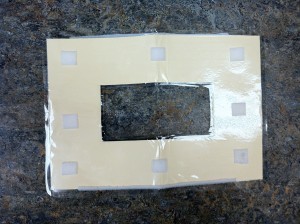
I find eye gaze with a simple picture array to be the easiest and most effective access method for many of my motor kids within movement activities. To make visual vocabulary accessible via eye gaze during movement activities, I place my picture symbols on communication aprons, small eye gaze boards, and on motor equipment itself (e.g., the ropes of swings, the handles of walkers). Traditional eye gaze frames are usually a bit too bulky for this type of communication situation, so I make my own frames out of clear plastic cutting board sheets or (in a real pinch) manila file folders. To make a quick eye gaze frame from a manila file folder (shown here), cut a square from the middle of the file folder, open it, and run it through a laminator. Then place your vocabulary on both sides-one to be viewed by the communicator and the other by the partner, since the manila folder isn’t transparent. These cheap and easy to make frames are great to send home with families too. Since they are so easy to make, you can even create activity-based eye gaze boards so you don’t have to juggle individual picture symbols.
5. High-Contrast Pictures are Awesome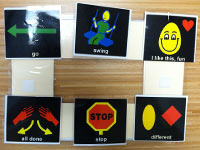
Many of my motor kids come to me with spotty vision history, making it very difficult to gauge how well they are using their visual systems to learn. I find that when I use high contrast symbols with these little ones-especially those that seem to struggle to visually attend to picture symbols consistently- that I get a lot more of them to use their eyes. This, of course, leads to much more consistent attention to aided language input, and eventually, more consistent use of eye gaze upon picture symbols to communicate.
The new high contrast symbol libraries for Boardmaker are well worth the investment if you’re working with kids who might have CVI. But, before our center invested in this addendum library, I was able to create some nice high contrast symbols by editing the existing symbols in Boardmaker and creating larger symbol cards (usually about 4 inches square). You can download the display here.
Working with these complex kids is never easy. Finding functional vocabulary that works within movement activities and translates into daily routines can be particularly tricky. With each session, I try to meet the child where he is at and adjust my strategies to move him just beyond that point. Sometimes, we spend the whole session just modeling one or two words across a variety of activities. My goal for many of these kids is to avoid learned helplessness in communication and promote early experiences that make them feel powerful and successful in their communicative attempts.
We hope to hear more about Tanna’s work in a future AACtual Therapy post. In the meantime, if you can read Tanna’s initial post here.
Filed under: PrAACtical Thinking
Tagged With: co-treating, cultural diversity, CVI, families, interpreter, low vision, PT, Tanna Neufeld, vision impairment
This post was written by Carole Zangari

